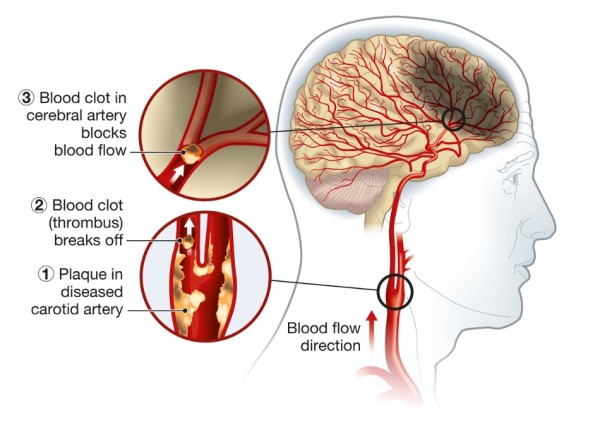Transient ischaemic attack | Mate rehu ohotata iti
Also called TIA, warning stroke or ministroke
Key points about transient ischaemic attack
- A transient ischaemic attack (TIA) is called a warning stroke or mini-stroke. It's a medical emergency and shouldn’t be ignored.
- A TIA happens when the blood supply to part of your brain is cut off by a blood clot. When the blood clot breaks up, the blood supply goes back to normal and the symptoms go away.
- Symptoms come on suddenly, and last a few seconds up to hours. If it lasts longer than 24 hours then it's a stroke.
- It's not possible to tell the difference between a TIA and a stroke at the beginning. Strokes can be treated.
- Call 111 immediately if you develop any of the symptoms listed below.

A transient ischaemic attack (TIA) happens when the blood supply to part of your brain is cut off by a blood clot. That part of your brain can’t do it’s job and you get symptoms in the part of the body it’s supposed to be controlling.
For example, if it’s the part of your brain that tells your arm to move, you won’t be able to move your arm. If the clot goes to the artery that leads to your eye you won't be able to see out of that eye. When the blood clot breaks up, the blood flows back and you can move your arm, or see, again. If the blood clot doesn’t break up, that part of the brain dies and it’s called a stroke.
Transient means it comes and goes again (or it's temporary), and ischaemic means starved of blood and oxygen.
The symptoms of a TIA are the same as those of a stroke, but unlike a stroke they only last for a few minutes or hours. It’s not possible to tell the difference at the beginning, so the best thing to do is act as if it is a stroke – call 111.
Like a stroke, the signs and symptoms of a TIA usually begin suddenly.
The main symptoms can be remembered with the word FAST: Face-Arms-Speech-Time.
- Face – has the face dropped on one side? Is one side of the smile droopy?
- Arms – can both arms be lifted about the head and kept there, or is one arm weak or numb?
- Speech – is speech slurred or garbled?
- Time – lost time is lost brain. Dial 111 immediately if you notice any of these signs or symptoms.
The video in English below shows the symptoms of a TIA or stroke. Know the signs of stroke. Think FAST: FACE drooping, ARM weakness, SPEECH difficulty, TAKE ACTION to call 111.'
Video: Know the signs of stroke – think FAST (English)
(Ministry of Health, NZ, 2018)
Video: Know the signs of stroke – think FAST (te reo Māori)
The same video in te reo. Take action – he poto te wā. Waea tonu atu ki 111. Kia pai ai te whakaoranga o te tangata.
The carotid and vertebral arteries in your neck are the main blood vessels that take blood from your heart to your brain. Atheroma or plaque can build up inside these arteries. Atheroma is made of fat and cholesterol in the wall of the artery and, as it builds up, it makes them narrower and stiffer. This is also called hardening of the arteries or atherosclerosis. A blood clot can form on the surface of the plaque. If a piece of blood clot breaks off it gets swept upstream until it gets stuck in a smaller artery in your brain.
Another place blood clots can come from is your heart. If your heart isn’t beating properly, a rhythm problem called atrial fibrillation, blood can stay in your heart too long and clot. The clots can then get swept upstream to your brain.
Little blood clots in your arteries block the blood supply to that part of your brain, so it doesn’t work properly. That's when you get the symptoms of a TIA. Small blood clots usually break up quickly so no permanent damage is done.
If the blood clot doesn’t break up the brain is starved of oxygen for too long and the brain cells die. This a stroke.
You may have more than one TIA, and the signs and symptoms of each may be similar or different depending on which part of your brain the clot goes to.

Image credit: Depositphotos
The things that increase your chances of having a TIA are the same as those that increase your risk of stroke.
Risk factors for RIA and stroke
- High blood pressure.
- High blood cholesterol.
- Diabetes.
- Smoking.
- High alcohol intake.
- Being overweight or obese.
- Atrial fibrillation.
- Lack of physical activity.
- Family history.
- Increasing age.
Check your risk with the Stroke Riskometer app developed by the Auckland University of Technology.
If you think you might have had a TIA, contact your healthcare provider.
- You'll be examined to check out other possible causes for your symptoms, and to check for signs of what is happening in your brain.
- You'll have a blood test, have your blood pressure taken and have an ECG.
- It's not always necessary to have a scan of your head, but this will sometimes be needed if it's not clear what's happening.
- Your healthcare provider may arrange for you to have an ultrasound of your carotid arteries to check for atherosclerosis. If your arteries are very narrow, surgery called endarterectomy can help prevent future TIAs and strokes.
What if I'm fully recovered or it happened a long time ago?
Even if your symptoms went away in a few minutes it's important that you see a healthcare provider straight away. This is because there's a high chance of having a stroke in the first week after a TIA – especially in the first 2 days.
If you think you might have had a TIA in the past see your GP or nurse practitioner. It's important to try and stop having a TIA or stroke in the future.
Although the symptoms of a TIA go away in a few minutes or hours, you'll need treatment to help prevent another TIA or a full stroke happening in the future. Your treatment will depend on your individual circumstances, such as your age and medical history. Treatment usually includes medicine to reduce the risk of blood clots forming such as:
| Medicine | Description |
| Anti-platelet treatment |
|
| Anticoagulant treatment |
|
| Antihypertensives to to lower your blood pressure |
|
| Statins to lower your cholesterol |
|
You won't be safe to drive for 1 month after your TIA. This is because of the high risk of having another TIA or stroke while driving.
If you are having a TIA – the best thing you can do to care for yourself is call 111.
If you have already had a TIA – you can lower the risk of having another one, or having a stroke. Take this chance to think about what you can do for your health. This is one of those times when choosing to take medicine really does make a difference to how long you live, and how well you live.
You can lower your chance of having a TIA or stroke by:
- getting active
- eating well
- quitting smoking
- keeping good control of your blood glucose if you have diabetes
- sticking to no more than 1 or 2 drinks of alcohol a day, no more than 5 days a week.
Apps reviewed by Healthify
You may find it useful to look at some Stroke apps, Self-management and healthy living apps, Heart failure apps, and Heart rate apps.
Many people who have a TIA will go on to have more TIAs. About 1–2 in 10 people who have a TIA have a stroke within the next year. This is much higher than the risk of someone the same age who hasn't had a TIA. About 3 in 100 people will have a heart attack within a year of having a TIA. This is because the risks, and what happens inside the arteries of the heart, are very similar. Taking control of your blood pressure, cholesterol and other risks are the best way to lower the chance of this happening.
TIA or ministroke(external link) Stroke Aotearoa New Zealand
Transient ischaemic attack(external link) NHS Choices, UK
Transient ischaemic attack – explained(external link) Watch, Learn, Live – Interactive Cardiovascular Library – American Heart Association, US
Brochures
What is a TIA (transient ischaemic attack)?(external link) Stroke Foundation of NZ
Transient ischaemic attack(external link) NHS, UK
Apps
Stroke apps
Self-management and healthy living apps
Heart failure apps
Heart rate apps
References
TIA guideline(external link) Health New Zealand | Te Whatu Ora Counties Manukau
Transient ischaemic attacks(external link) NHS, UK
Transient ischaemic attacks(external link) Patient Info (Doctor), UK
Clinical resources
Transient ischaemic attacks(external link) Patient Info, doctor, UK
Webinars
Video: Stroke and TIA, what's new
(Goodfellow Unit Webinar, NZ, 2020)
Video: Managing common neurological conundrums
(Goodfellow Unit Webinar, NZ, 2020)
Pharmac seminars
Video: Interactive cases, neuromuscular and stroke, Dr Anna Ranta – Dr Anna Ranta (36 minutes)
(PHARMAC Seminars, 2019)
Podcast
Transient Ischemic Attacks – Alan Barber(external link) Goodfellow Unit, NZ, 2016 (26 minutes)
Professor Alan Barber talks about the diagnosis and management of transient ischemic attacks in primary care. Alan is lead neurologist for Auckland Hospital Stoke Service and holds the Neurological Foundation of New Zealand Chair in Clinical Neurology at the University of Auckland.
Credits: Healthify editorial team. Healthify is brought to you by Health Navigator Charitable Trust.
Reviewed by: Dr Emma Dunning, Clinical Editor and Advisor
Last reviewed:
Page last updated:





